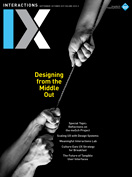Authors:
Isabel Qamar, Rainer Groh, David Holman, Anne Roudaut
Many interactive devices such as laptops and mobile phones currently have static, planar shapes that are arguably not particularly adapted to the user. Recent developments in display and material technologies have enabled explorations into morphing devices [1,2] that can provide improved affordances for human interaction. From interactive spherical displays, to mobile phones that bend to notify a user of an incoming call, to pneumatic interfaces that expand to become exoskeletons or couches, there are many recent examples of shaped interface design. This transition from flat, planar shapes to morphing interfaces requires human-computer interaction (HCI) practitioners to learn about and…
You must be a member of SIGCHI, a subscriber to ACM's Digital Library, or an interactions subscriber to read the full text of this article.
GET ACCESS
Join ACM SIGCHIIn addition to all of the professional benefits of being a SIGCHI member, members get full access to interactions online content and receive the print version of the magazine bimonthly.
Subscribe to the ACM Digital Library
Get access to all interactions content online and the entire archive of ACM publications dating back to 1954. (Please check with your institution to see if it already has a subscription.)
Subscribe to interactions
Get full access to interactions online content and receive the print version of the magazine bimonthly.






